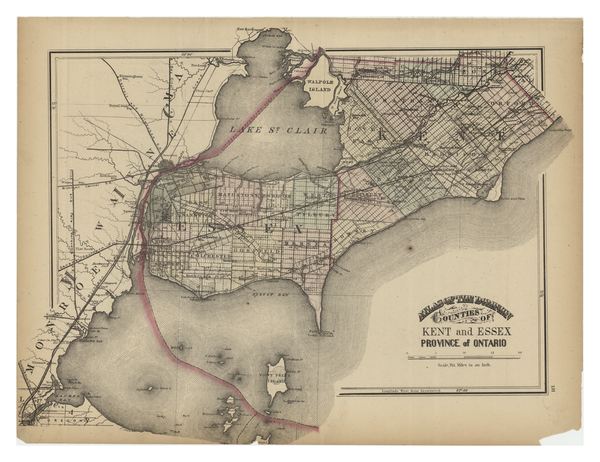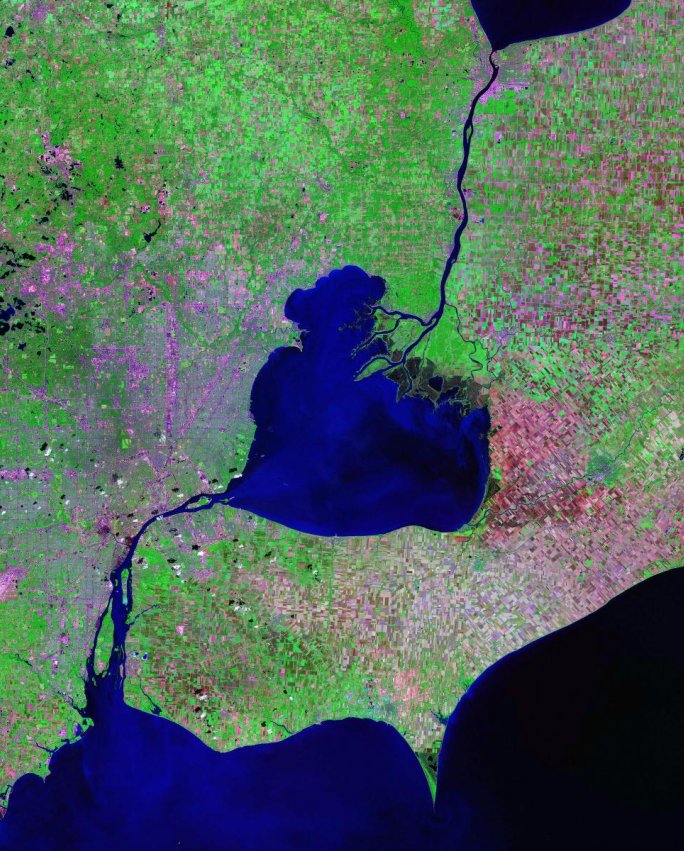|
Western District, Upper Canada
Western District was one of four districts of the Province of Quebec created in 1788 in the western reaches of the Montreal District which were later detached in 1791 to create the new colony of Upper Canada. Known as Hesse District (named after Hesse in Germany) until 1792, it was abolished in 1849. Historical evolution The District originally consisted of that part of the Province of Quebec west of "a north and south line, intersecting the extreme projection of Long Point into the lake Erie," being the territory described as: As Detroit was still occupied British territory in 1792, it formed part of the District at the time. In the first election to the Legislative Assembly of Upper Canada, three former or current residents of Detroit were elected. This anomaly, together with other occupied places at Fort Mackinac and Fort Miami, were finally vacated upon the ratification of the Jay Treaty in 1795; they were withdrawn from the District in June 1796. The District, after d ... [...More Info...] [...Related Items...] OR: [Wikipedia] [Google] [Baidu] |
Province Of Quebec (1763–1791)
The Province of Quebec (french: Province de Québec) was a colony in British North America which comprised the former French colony of Canada (New France), Canada. It was established by the Kingdom of Great Britain in 1763, following the conquest of New France by British forces during the Seven Years' War. As part of the Treaty of Paris (1763), Treaty of Paris, Kingdom of France, France gave up its claim to the colony; it instead negotiated to keep the small profitable island of Guadeloupe. Following the Royal Proclamation of 1763, Canada was renamed the Province of Quebec, and extended from the coast of Labrador on the Atlantic Ocean, southwest through the Saint Lawrence River Valley to the Great Lakes and beyond to the confluence of the Ohio River, Ohio and Mississippi Rivers. Portions of its southwest, those areas south of the Great Lakes, were later ceded to the newly established United States in the Treaty of Paris (1783) at the conclusion of the American Revolution; alt ... [...More Info...] [...Related Items...] OR: [Wikipedia] [Google] [Baidu] |
Kent County, Ontario
Kent County, area 2,458 km2 (949 sq mi) is a historic county in the Canadian province of Ontario. The county was created in 1792 and named by John Graves Simcoe in honour of the English County. The county is in an alluvial plain between Lake St. Clair, and Lake Erie, watered by two navigable streams, the Thames River and the Sydenham River. On January 1, 1998, the county, its townships, towns, and Chatham were amalgamated into the single-tier city of Chatham-Kent. Original townships Camden Area: . Camden Township was conceded by treaty in 1790, and the Gore was surrendered by treaty in 1819. Surveyed in 1794 and named from the Earl of Camden. Also referred to earlier as Camden Township and Gore, and in the 1861 census as Camden & Gore Township. Containing some of the best farmland in Ontario, the township was originally parcelled as a grid with Concessions 1 to 7 running north-westward, Lots 1 to 18 running north-eastward and Concession A along the road to Thames ... [...More Info...] [...Related Items...] OR: [Wikipedia] [Google] [Baidu] |
Districts Of Upper Canada
A district is a type of administrative division that, in some countries, is managed by the local government. Across the world, areas known as "districts" vary greatly in size, spanning regions or counties, several municipalities, subdivisions of municipalities, school district, or political district. By country/region Afghanistan In Afghanistan, a district (Persian ps, ولسوالۍ ) is a subdivision of a province. There are almost 400 districts in the country. Australia Electoral districts are used in state elections. Districts were also used in several states as cadastral units for land titles. Some were used as squatting districts. New South Wales had several different types of districts used in the 21st century. Austria In Austria, the word is used with different meanings in three different contexts: * Some of the tasks of the administrative branch of the national and regional governments are fulfilled by the 95 district administrative offices (). The area a dist ... [...More Info...] [...Related Items...] OR: [Wikipedia] [Google] [Baidu] |
Wayne State University Press
Wayne State University Press (or WSU Press) is a university press that is part of Wayne State University. It publishes under its own name and also the imprints Painted Turtle and Great Lakes Books Series. History The Press has strong subject areas in Africana studies; fairy-tale and folklore studies; film, television, and media studies; Jewish studies; regional interest; and speech and language pathology. Wayne State University Press also publishes eleven academic journals, including ''Marvels & Tales'', and several trade publications, as well as the ''Made in Michigan Writers Series''. WSU Press is located in the Leonard N. Simons Building on Wayne State University's main campus. An editorial board approves the Wayne State University Press's titles. The board considers proposals and manuscripts presented by WSU Press's acquisitions department. WSU Press also has a Board of Visitors, dedicated to fundraising and advocacy in support of the Press. Officially, WSU Press is an ... [...More Info...] [...Related Items...] OR: [Wikipedia] [Google] [Baidu] |
Windsor, Ontario
Windsor is a city in southwestern Ontario, Canada, on the south bank of the Detroit River directly across from Detroit, Michigan, United States. Geographically located within but administratively independent of Essex County, it is the southernmost city in Canada and marks the southwestern end of the Quebec City–Windsor Corridor. The city's population was 229,660 at the 2021 census, making it the third-most populated city in Southwestern Ontario, after London and Kitchener. The Detroit–Windsor urban area is North America's most populous trans-border conurbation, and the Ambassador Bridge border crossing is the busiest commercial crossing on the Canada–United States border. Windsor is a major contributor to Canada's automotive industry and is culturally diverse. Known as the "Automotive Capital of Canada", Windsor's industrial and manufacturing heritage is responsible for how the city has developed through the years. History Early settlement At the time when the fir ... [...More Info...] [...Related Items...] OR: [Wikipedia] [Google] [Baidu] |
Parliament Of The Province Of Canada
The Parliament of the Province of Canada was the legislature for the Province of Canada, made up of the two regions of Canada West (formerly Upper Canada, later Ontario) and Canada East (formerly Lower Canada, later Quebec). Creation of the Parliament The Province of Canada was created by an Act of the British Parliament, the ''Act of Union 1840'', which was proclaimed in force by the Governor General of the Canadas, Lord Sydenham, effective February 10, 1841. The Act united the two provinces of Lower Canada and Upper Canada into a single province, with a single parliament. The parliaments of Lower Canada and Upper Canada were abolished. Lower Canada was renamed Canada East, and Upper Canada was renamed Canada West, but the two regions were administrative divisions only. They did not have separate governments. The Union had been recommended by Lord Durham in his Report on the Affairs of British North America, in response to the Rebellions of 1837–1838 in both Lower Canada a ... [...More Info...] [...Related Items...] OR: [Wikipedia] [Google] [Baidu] |
Lambton County
Lambton County is a county in Southwestern Ontario, Canada. It is bordered on the north by Lake Huron, which is drained by the St. Clair River, the county's western border and part of the Canada-United States border. To the south is Lake Saint Clair and Chatham-Kent. Lambton County's northeastern border follows the Ausable River and Parkhill Creek north until it reaches Lake Huron at the beach community of Grand Bend. The county seat is in the Town of Plympton-Wyoming. The largest city in Lambton County is Sarnia, which is located at the source of the St. Clair River at Lake Huron. The two Blue Water Bridges cross the river at Sarnia, connecting it to Port Huron, Michigan. The bridges are one of the busiest border crossings between the two countries. The river is also traversed by one passenger ferry further south, and a rail tunnel, also at Sarnia, runs underneath it. The CN rail tunnel accommodates double stacked rail cars. Along with Sarnia, the population centres in Lambton Co ... [...More Info...] [...Related Items...] OR: [Wikipedia] [Google] [Baidu] |
Detroit River
The Detroit River flows west and south for from Lake St. Clair to Lake Erie as a strait in the Great Lakes system. The river divides the metropolitan areas of Detroit, Michigan, and Windsor, Ontario, Windsor, Ontario—an area collectively referred to as Detroit–Windsor—and forms part of the Canada–United States border, border between Canada and the United States. The Ambassador Bridge, the Detroit–Windsor Tunnel, and the Michigan Central Railway Tunnel connect the cities. The river's English name comes from the French language, French (translated as "River of the Strait"). The Detroit River has served an important role in the history of Detroit and Windsor, and is one of the world's busiest waterways. It is an important transportation route connecting Lake Michigan, Lake Huron, and Lake Superior to Lake Erie and eventually to Lake Ontario, the Saint Lawrence Seaway, St. Lawrence Seaway and the Erie Canal. When Detroit underwent rapid industrialization at the turn of th ... [...More Info...] [...Related Items...] OR: [Wikipedia] [Google] [Baidu] |
Wyandot People
The Wyandot people, or Wyandotte and Waⁿdát, are Indigenous peoples of the Northeastern Woodlands. The Wyandot are Iroquoian Indigenous peoples of North America who emerged as a confederacy of tribes around the north shore of Lake Ontario with their original homeland extending to Georgian Bay of Lake Huron and Lake Simcoe in Ontario, Canada and occupying some territory around the western part of the lake. The Wyandot, not to be mistaken for the Huron-Wendat, predominantly descend from the Tionontati tribe. The Tionontati (or Tobacco/Petun people) never belonged to the Huron (Wendat) Confederacy. However, the Wyandot(te) have connections to the Wendat-Huron through their lineage from the Attignawantan, the founding tribe of the Huron. The four Wyandot(te) Nations are descended from remnants of the Tionontati, Attignawantan and Wenrohronon (Wenro), that were "all unique independent tribes, who united in 1649-50 after being defeated by the Iroquois Confederacy." After thei ... [...More Info...] [...Related Items...] OR: [Wikipedia] [Google] [Baidu] |
Walpole Island First Nation
Walpole Island is an island and First Nation reserve in southwestern Ontario, Canada, on the border between Ontario and Michigan in the United States. It is located in the mouth of the St. Clair River on Lake St. Clair, about by road from Windsor, Ontario and from Detroit, Michigan. It is unceded territory and is inhabited by the Ojibwe, Potawatomi, and Odawa peoples of the Walpole Island First Nation, who call it Bkejwanong, meaning "where the waters divide" in Anishinaabemowin. In addition to Walpole Island, the reserve includes Squirrel Island, St. Anne Island, Seaway Island (except a small U.S. portion), Bassett Island, and Potawatomi Island. The river or creeks that separate these islands provide the area with its other commonly used name, Swejwanong or "many forks of a river." It is independent of, but within the geographic region of, Lambton County and adjoins the municipality of Chatham-Kent and the township of St. Clair. Across the St. Clair River to the west a ... [...More Info...] [...Related Items...] OR: [Wikipedia] [Google] [Baidu] |
Lake St
Lake Street may refer to: *Lake Street (Chicago) *Lake Street (Minneapolis) Lake Street is a major east-west thoroughfare between 29th and 31st streets in Minneapolis, Minnesota United States. From its western most end at the city's limits, Lake Street reaches the Chain of Lakes, passing over a small channel linking B ... See also * Lake Street station (other) {{dab, road ... [...More Info...] [...Related Items...] OR: [Wikipedia] [Google] [Baidu] |




